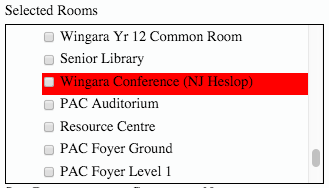This is an Early Draft
What is this? – In the event where an event request form has been submitted and its time and location clashes with a pre-existing event, the following steps should be followed to resolve the clash.
N.b. Any uncertainty as to approaching an event clash, including worries of any sensitivities around clashes, can of course be referred directly to the mediator for them to undertake the following steps in resolving an event clash.
Step 1. Contact the party who has applied for the event to see if an alternative time or location would be acceptable. Use the room selection step from Step 4 – Location of the Event Creation Procedure to help you find available rooms for that time slot.
Booked rooms will be highlighted in red, whereas available rooms will not be highlighted.
If a new available location for that event is agreed on, proceed with the Event Creation Procedure as normal.
Step 2. In the event that the party that is requesting an event insists that the event must take place at the specified time and location in spite of a pre-existing event, a single email addressed ‘To’ both parties must be sent from the person who is responsible for creating that event in edumate, informing both parties of the following:
- Name of the pre-existing event and students involved
- Name of the person responsible for the pre-existing event
- Name of the event wishing to replace the pre-existing event and students involved
- Name of the person responsible for the new event
- Name and contact details of the mediator who can help with the clash resolution.
- Clear notification that there is a request to replace a pre-existing event as per the above details that needs to be resolved externally between those two parties and with the assistance of the mediator where necessary. without involvement of the , Clear notification that both parties must each reply to this email directly with acknowledgement of the mutual external resolution before the events can be created and updated.
Once again if the parties are dissatisfied with the process they should contact Who’s the mediator? to mediate the resolution process and should not be involved with any disputes themselves beyond initial notification and eventual receipt of the email-acknowledgement of the resolution.
A draft email to the parties involved in the clash is as follows:
To: party1, party2, mediator
Subject: Request to alter an event booking (or something like this)
Dear …
Email body…
Regards …
N.b. Any dispute or resolution itself is not the responsibility of the person creating the event, they are solely responsible for notifying the parties of a clash and those parties obligation to respond to the above email with a confirmation of the resolution. Any communications relating to the clash/dispute itself should be politely referred to the mediator if the parties aren’t wishing to resolve it between themselves.
Step 3. Once an email reply has been received from both parties acknowledging the mutual resolution, the events should be created and potentially pre-existing events updated to reflect this resolution. The two confirmation reply emails from the parties should be archived together for future reference.
